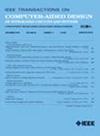Finite Element Approach Based Numerical Framework for Device Simulator
IF 2.9
3区 计算机科学
Q2 COMPUTER SCIENCE, HARDWARE & ARCHITECTURE
IEEE Transactions on Computer-Aided Design of Integrated Circuits and Systems
Pub Date : 2025-01-17
DOI:10.1109/TCAD.2025.3531343
引用次数: 0
Abstract
In this work, a finite element method (FEM)-based numerical framework is proposed to effectively calculate the drift-diffusion equations and compiled into a parallel computing device simulator. In this framework, a novel upwind FEM is developed to solve the convection dominated continuity equations. In the implementation of the upwind method, the vector basis functions are employed to interpolate the edge streamline upwind (SU) current densities into mesh grid to obtain the spatial current density, and then the scalar FEM is used to construct the element matrix equation. Through comparing the calculating results of a 2-D PN-junction with those obtained by the COMSOL Semiconductor, the accuracy of proposed framework is verified first. Then, through several numerical cases, its advantages in comparison with FBSG-, SU Petrov Galerkin (SUPG)-, or control-volume-finite-element method SUPG-based frameworks in terms of mesh grid adaptivity, computing stability, and efficiency are presented. At last, by combining the proposed framework with a domain decomposition scheme and a fully coupled Newton’s approach, a parallel computing device simulator is developed, including both steady-state and transient solvers. The performance of the in-house simulator is evaluated in terms of calculating accuracy, large-scale problem solution capability, and scalabilities.基于有限元方法的器件模拟器数值框架
本文提出了一种基于有限元法的数值框架来有效地计算漂移扩散方程,并将其编译成并行计算设备模拟器。在此框架下,提出了一种新的迎风有限元方法来求解对流主导的连续方程。在逆风法的实现中,首先利用矢量基函数将边缘流线逆风电流密度插值到网格中,得到空间电流密度,然后利用标量有限元法构建单元矩阵方程。通过将二维pn结的计算结果与COMSOL半导体公司的计算结果进行比较,首先验证了所提框架的准确性。然后,通过几个数值算例,比较了其与基于FBSG-、SU Petrov Galerkin (SUPG)-或基于控制体积有限元法SUPG-的框架相比,在网格自适应性、计算稳定性和效率方面的优势。最后,将所提出的框架与区域分解格式和全耦合牛顿方法相结合,开发了一个并行计算设备模拟器,包括稳态和瞬态求解器。内部模拟器的性能根据计算精度、大规模问题解决能力和可扩展性进行评估。
本文章由计算机程序翻译,如有差异,请以英文原文为准。
求助全文
约1分钟内获得全文
求助全文
来源期刊
CiteScore
5.60
自引率
13.80%
发文量
500
审稿时长
7 months
期刊介绍:
The purpose of this Transactions is to publish papers of interest to individuals in the area of computer-aided design of integrated circuits and systems composed of analog, digital, mixed-signal, optical, or microwave components. The aids include methods, models, algorithms, and man-machine interfaces for system-level, physical and logical design including: planning, synthesis, partitioning, modeling, simulation, layout, verification, testing, hardware-software co-design and documentation of integrated circuit and system designs of all complexities. Design tools and techniques for evaluating and designing integrated circuits and systems for metrics such as performance, power, reliability, testability, and security are a focus.

 求助内容:
求助内容: 应助结果提醒方式:
应助结果提醒方式:


